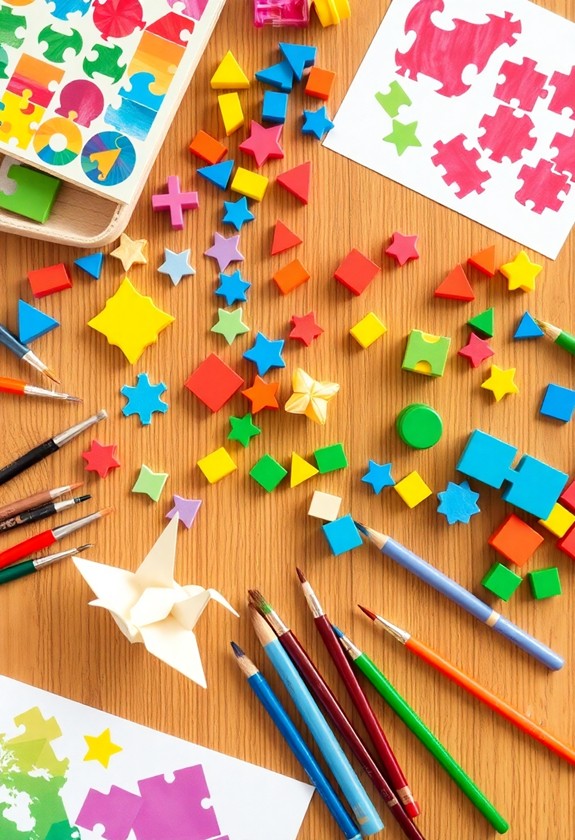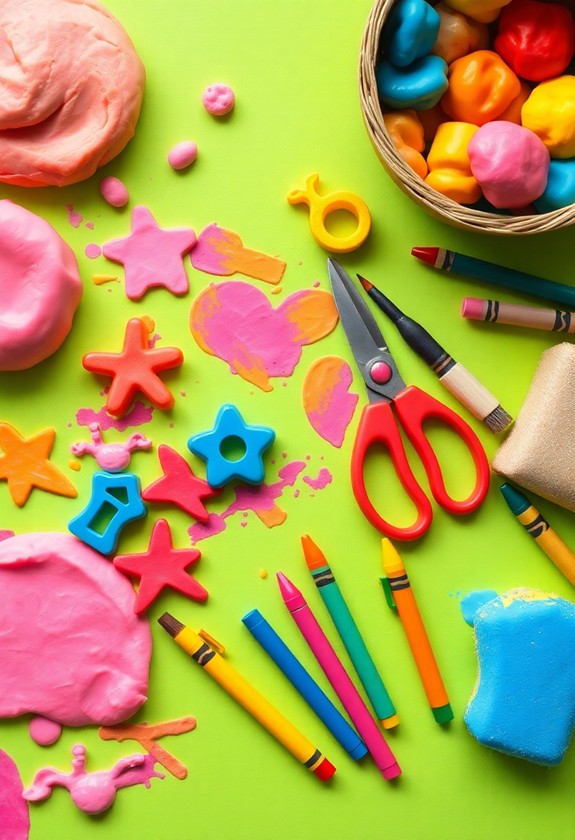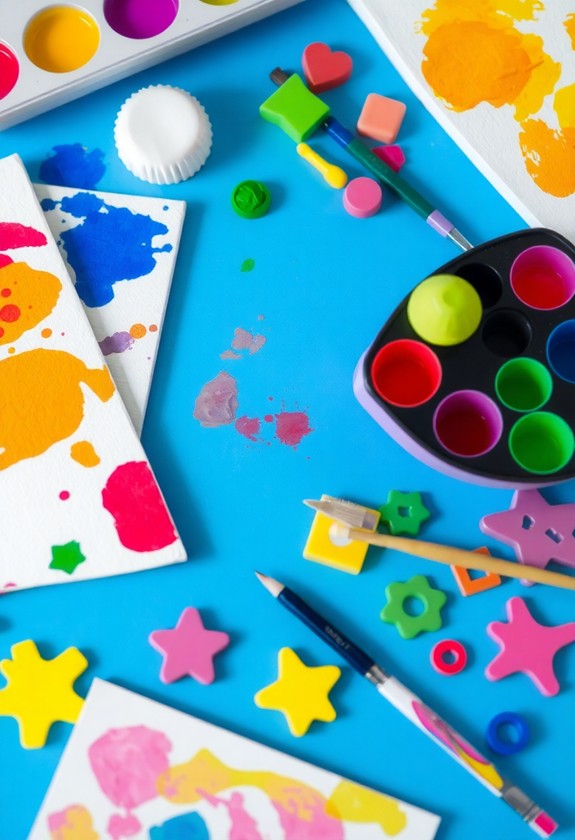Get ready to release your child's inner artist and problem-solver! These 7 fantastic art projects will spark creativity and boost critical thinking skills: Mixed Media Collage, Recycled Sculpture Building, Abstract Painting With Restrictions, Collaborative Mural Design, Geometric Shape Puzzle Art, Nature-Inspired Land Art, and Color Mixing Experiments. From arranging magazine cutouts to building with recycled materials, your little one will face fun challenges that encourage out-of-the-box thinking. They'll learn to adapt, communicate, and persist through artistic obstacles. Plus, these hands-on activities develop fine motor skills and sensory awareness. Immerse yourself in this colorful world of artistic problem-solving, and watch your child's imagination soar!
Creative Highlights
- Mixed media collage creation enhances problem-solving by combining various materials and balancing compositions.
- Recycled material sculpture building challenges structural problem-solving and creative use of everyday objects.
- Abstract painting with restrictions promotes innovative thinking and adaptability in artistic expression.
- Collaborative mural design fosters teamwork and problem-solving in large-scale artistic projects.
- Geometric shape puzzle art develops spatial awareness and cognitive skills through creative arrangements.
Mixed Media Collage Creation

Blending various materials and textures, mixed media collage creation is an excellent way to improve problem-solving skills. You'll love this fun project that gets your creative juices flowing! Here's how to get started:
- Gather materials: magazines, fabric scraps, buttons, paint, glue, and more!
- Choose a theme or concept for your collage
- Start arranging pieces on your canvas or paper
- Experiment with different layouts and combinations
Multi-sensory experiences like this aid in memory retention and information processing, essential for early childhood development. This activity is perfect for toddlers aged 1-5 to maximize brain benefits.
As you work, you'll face challenges like:
- How to make pieces fit together
- Balancing colors and textures
- Deciding what to add or remove
But don't worry! That's where the problem-solving magic happens. You'll learn to think outside the box and come up with creative solutions. And the best part? There's no right or wrong way to do it. So get messy and have a blast!
Recycled Material Sculpture Building
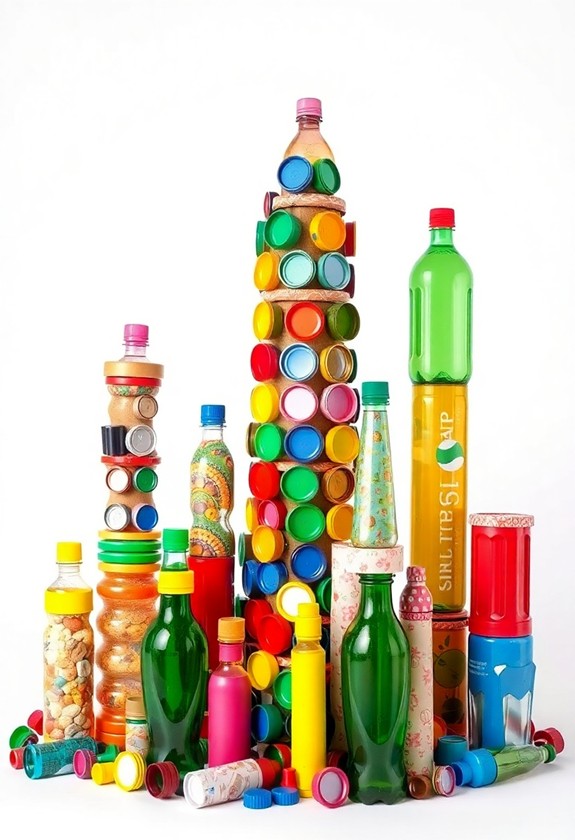
Recycled Material Sculpture Building takes problem-solving to a whole new level. It's like a super-fun puzzle where you're the master builder! You'll gather all sorts of cool junk – old bottles, cardboard boxes, even broken toys – and transform them into amazing 3D art!
Here's how to get started:
- Collect your recycled treasures
- Brainstorm your sculpture idea
- Experiment with different combinations
But wait, there's more! You'll face exciting challenges like:
- How to make things stick together
- Balancing wobbly pieces
- Creating sturdy structures
As you build, you'll uncover new ways to use everyday items. Who knew a cereal box could become a robot's head? Or that bottle caps make perfect eyes? Your imagination is the limit! So, get ready to think outside the box (or maybe use that box!) and sculpt your way to problem-solving success!
Abstract Painting With Restrictions
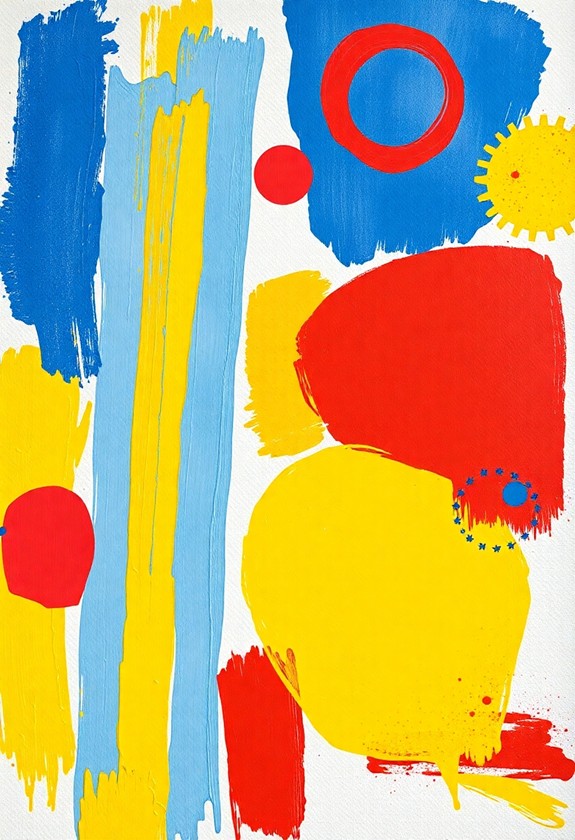
Plunge into the world of Abstract Painting With Restrictions and watch your problem-solving skills soar! This exciting challenge will push your creativity to new heights. Here's how it works:
- Grab your art supplies, but wait! You can't use everything.
- Set some fun limitations, like:
- Only use 3 colors
- No brushes allowed – paint with your hands or unusual objects
- Create shapes without lifting your tool from the canvas
These restrictions force you to think outside the box and find clever solutions. You'll be amazed at what you can create! For younger artists, consider using washable finger paints to make cleanup easier and encourage sensory exploration. As you work, ask yourself:
- How can I mix these colors to get new shades?
- What household items could make interesting textures?
Collaborative Mural Design

From individual expression, we now shift our focus to group creativity with Collaborative Mural Design. Get ready for an exciting team challenge! You'll work together to create a stunning mural that solves a visual puzzle. But here's the twist: each person gets a different set of tools and colors!
Imagine the scene:
- Colorful paint splatters everywhere!
- Friends laughing and brainstorming ideas
- A giant blank wall waiting to be transformed
- Paintbrushes, rollers, and sponges galore
You'll need to communicate, compromise, and think outside the box to make your mural masterpiece. Can't reach that high spot? Problem-solve it! Maybe create a human ladder or use a long-handled brush. As you work, you'll uncover new ways to blend your skills and overcome obstacles. It's like a giant, artistic jigsaw puzzle – and you're the pieces that fit together perfectly!
Geometric Shape Puzzle Art
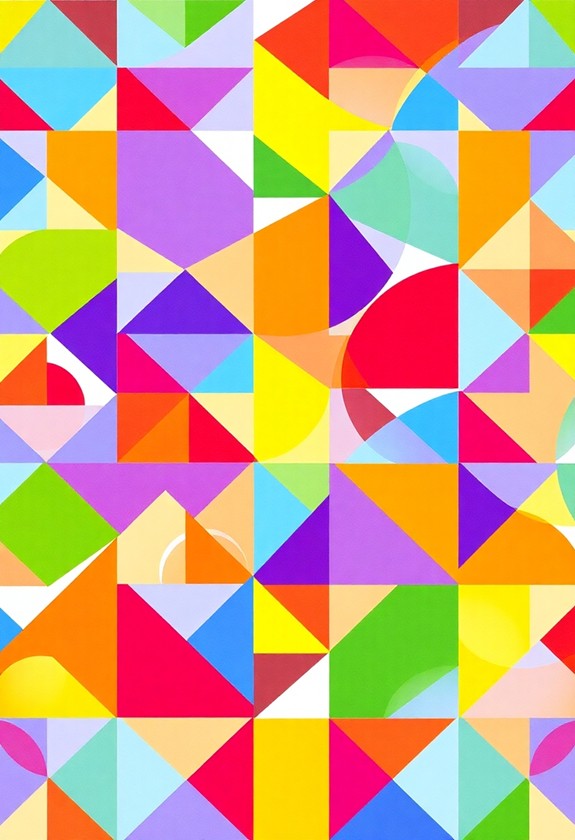
Now that we've examined collaborative art, let's explore the fascinating world of Geometric Shape Puzzle Art. You'll love this mind-bending project! It's like solving a puzzle and creating art at the same time. How cool is that?! This activity not only improves problem-solving skills but also promotes cognitive development and encourages creative expression in a screen-free environment.
Here's what you'll need to do:
- Grab some colorful paper and scissors
- Cut out various geometric shapes (triangles, squares, circles)
- Mix them up and challenge yourself to create a picture
The trick is to arrange these shapes in creative ways. Can you make a robot? A cityscape? An abstract masterpiece? The possibilities are endless! As you work, you'll be flexing your problem-solving muscles and boosting your spatial awareness. Plus, it's so much fun you won't even realize you're learning!
Nature-Inspired Land Art
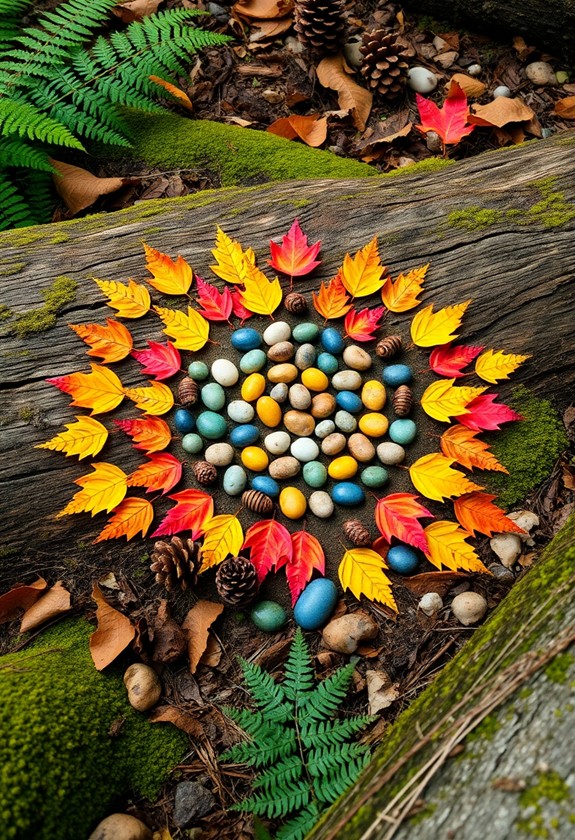
Moving from geometric shapes to organic forms, Nature-Inspired Land Art offers a unique way to engage with the environment during honing problem-solving skills. You'll love creating art with natural materials found outdoors! This exciting project challenges you to think creatively and work with what nature provides. Imagine the possibilities:
- Spiraling patterns with colorful leaves
- Rock stacks defying gravity
- Intricate designs using twigs and pebbles
- Woven grass structures swaying in the breeze
Rock painting is another fantastic activity that combines creativity with outdoor exploration, perfect for toddlers and older children alike. Get ready to problem-solve on the spot! You'll need to reflect on balance, structure, and durability as you build. But don't worry, that's part of the fun! If something doesn't work, try again. Every attempt is a learning experience. As you create, you're not just making art – you're developing critical thinking skills. So, head outside and let nature be your canvas!
Color Mixing Experiments
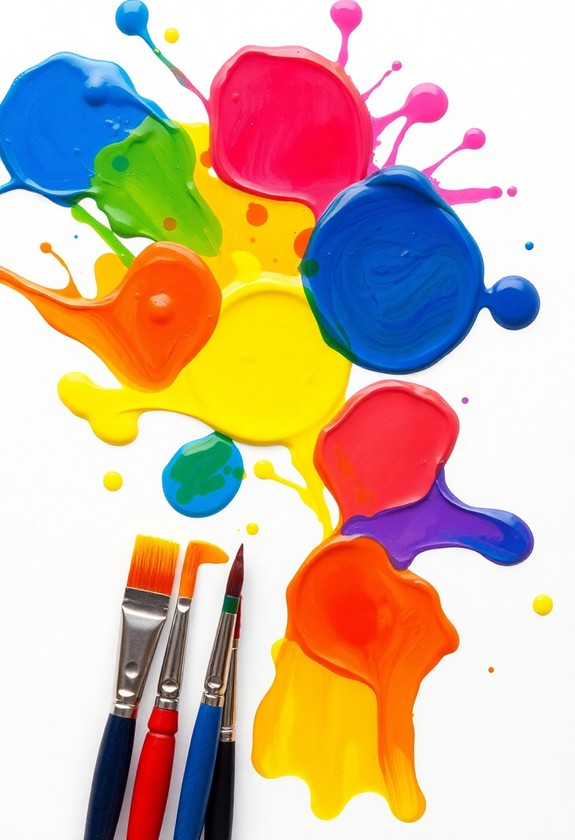
Considering the previous outdoor activities, Color Mixing Experiments bring the problem-solving fun indoors. You'll love this colorful challenge! Grab your paints and get ready to mix it up! This activity is perfect for toddler Sunday school and can help develop fine motor skills during investigating colors.
Here's what you'll need:
- Primary colors (red, blue, yellow)
- White paper
- Paintbrushes
- Mixing palette
Now, let's get creative:
- Start with the basics – mix two primaries to make secondaries.
- Try adding white to create tints.
- Challenge yourself to match a specific color from an object in your room.
But wait, there's more! Can you make brown using only primary colors? How about creating a whole rainbow with just three paints? It's like being a color detective! You'll be amazed at how many shades you can create. And the best part? You're solving puzzles during making beautiful art!
Curious Little Questions
How Do Art Projects Improve Problem-Solving Skills in Non-Artistic Fields?
You'd think art projects are just for creating pretty pictures, but surprise! They're secret problem-solving boosters for all fields! When you tackle an art project, you're actually flexing your creative muscles. You'll:
- Think outside the box
- Adapt to challenges
- Find unique solutions
These skills aren't just for artists! They'll help you in science, business, and more. So, next time you're stuck on a non-art problem, grab some crayons! You might just color your way to a brilliant solution!
What Age Groups Benefit Most From Problem-Solving Art Activities?
You'll be thrilled to know that problem-solving art activities benefit all ages! From tiny tots to terrific teens and amazing adults, everyone can boost their skills. But here's the exciting part: kids aged 5-12 often see the biggest gains! Why? Their brains are like sponges, soaking up new ideas. Teens and adults, don't worry! You'll still see awesome improvements. The key is to start now, no matter your age. Get ready to release your inner problem-solving superhero through art!
Can These Projects Be Adapted for Individuals With Physical Disabilities?
Grab your time machine, as we're about to make art accessible for everyone! You bet these projects can be adapted for people with physical disabilities. It's all about thinking creatively! Use mouth-held brushes, eye-tracking technology, or even foot painting. Don't forget adaptive tools like ergonomic scissors and easy-grip pencils. And hey, why not try digital art? It's super flexible! Remember, art knows no boundaries. So let's get crafty and problem-solve our way to awesome adaptations!
How Often Should One Engage in Creative Activities for Optimal Benefits?
You'll love this! For best benefits, try to get creative every day! Even just 15-30 minutes can work wonders. But don't stress if you can't manage daily – aim for at least 2-3 times a week. Mix it up with different activities to keep things exciting:
- Doodle during lunch breaks
- Paint on weekends
- Try clay modeling in the evenings
Are There Any Potential Drawbacks to Using Art for Problem-Solving Development?
Are there drawbacks to using art for problem-solving? You bet! As you engage in art, it's super fun and helpful, there are a few things to watch out for:
- You might get too focused on art and forget other skills
- It can be frustrating if you're not naturally artistic
- Sometimes, it's hard to see how art connects to real-world problems
- Art supplies can be expensive!
But don't worry! These are small bumps on your creative path. Keep discovering, and you'll find the perfect balance!

